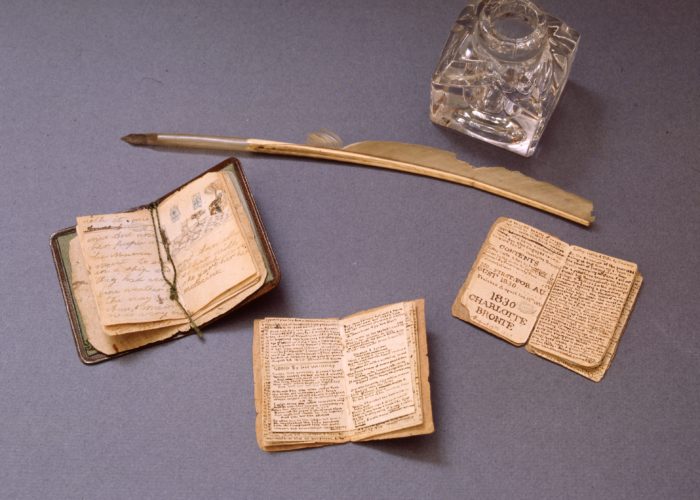Brontë little books
Theme: The arts in the Age of Revolution, Social and cultural revolution, Printing revolution
The Brontës – Charlotte (1816-1855), Emily (1818-1849) and Anne (1820-1849), are the most famous sisters in English Literature. Their insightful, dramatic and often subversive novels, published in the mid 1800s, provide a unique window into the social conditions of the time. With unforgettable characters like Jane Eyre and Heathcliff, and themes which are still highly relevant today, their stories have become classics and been adapted over and over again for stage and screen.
Charlotte, Emily and Anne Brontë lived in Haworth in West Yorkshire, along with their brother Branwell, their mother having died in 1821, when Anne was just 20 months old. Their father Patrick (who was the parish priest) had migrated from Ireland, and changed his name from Prunty – perhaps out of admiration for Horatio Nelson (1st Duke of Bronté), and perhaps to distance himself from his brother William who had been a founding member of the United Irishmen and taken part in the 1798 uprising. The siblings were close, writing stories and plays together, and inventing imaginary worlds to amuse themselves.
Anne, Emily and Charlotte dreaded the prospect of a life spent as a governess, but at the time, their chosen profession of writing was still widely regarded as something that ‘young ladies’ simply did not do. They agreed to work together on a book of poetry under pseudonyms (false names) and publish it using their own money. They chose three unusual names which were neither traditionally male or female, each beginning with the same letters as their own initials. The Poems of Currer, Acton and Ellis Bell was published in 1846.
The sisters went on to write and publish some of the most famous works of the time. Among these were Emily’s Wuthering Heights (1847) – regarded by many at the time as shocking, both for its sense of sexual passion and scenes of physical and mental cruelty. Charlotte found fame with Jane Eyre (1847) and Anne with The Tenant of Wildfell Hall (1848). Charlotte also wrote Shirley (1849), based partly on what her father had told her about Luddite machine–breaking in 1811-1812. Sadly, the sisters’ writing careers were to be short–lived, all three died young, and within six years of each other.
These ‘little books’, only a few centimetres in size, were hand-made by Charlotte, Emily and Anne. They consist of paper scraps sewn into covers made from everyday items such as sugar bags and wallpaper. In them the sisters created imaginary worlds, most notably in Anne and Emily’s Gondal saga.
Did you know..?
When ‘Wuthering Heights‘ was published in 1848 one reviewer wrote: “the reader is shocked, disgusted, almost sickened by details of cruelty, inhumanity, and the most diabolical hate and vengeance, and anon come passages of powerful testimony to the supreme power of love—even over demons in the human form.”
Use our Classroom resources to investigate this object and the Arts in the Age of Revolution further.
Highlights:
- Using objects, artworks and other sources to find out about the past
- Using museum collections as creative starters
And much more…
Sources & acknowledgements
This object description and its related educational resources were researched and written by our team of historians and education specialists. For further information see the item’s home museum, gallery or archive, listed above.
-
Did you know..?
When ‘Wuthering Heights‘ was published in 1848 one reviewer wrote: “the reader is shocked, disgusted, almost sickened by details of cruelty, inhumanity, and the most diabolical hate and vengeance, and anon come passages of powerful testimony to the supreme power of love—even over demons in the human form.”
-
Education overview
You can access a range of teachers resources related to this object and more on our education page.
Please also see our glossary of terms for more detailed explanations of the terms used.
-
Curatorial info
- Originating Museum: Bronte Parsonage Museum
- Production Date: 19th Century
- Creator: Charlotte, Emily and Anne Bronte
- Material: Paper
-
Use this image
- Rights Holder: © The Bronte Society
- License Type: All Rights Reserved



